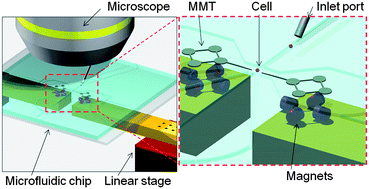This month’s issue is the next instalment in our series of 10th anniversary issues, this time focussing on the best new research from the Netherlands. Sabeth Verpoorte introduces the issue in her Editorial, describing the progression from macro- to microfluidics in this small, but scientifically strong country.
The issue features work on floating electrodes from Albert van den Berg, artificial cilia from P. R. Onck and J. Westerweel, capillary Stokes drift from Dirk van den Ende, microbubble generation from José Gordillo, two-phase flow systems from Sabeth Verpoorte and micromolding from Michiel Kreutzer.
The issue also features HOT articles from Ryan Bailey, Masaya Hagiwara and Daniel Chiu:












 Manipulating cells in microfluidic chips is often accomplished with a magnetically driven microtool (MMT), driven by a permanent magnet. However MMTs driven by permanent magnets suffer from low positioning accuracy and response speed. Here, Masaya Hagiwara (
Manipulating cells in microfluidic chips is often accomplished with a magnetically driven microtool (MMT), driven by a permanent magnet. However MMTs driven by permanent magnets suffer from low positioning accuracy and response speed. Here, Masaya Hagiwara (